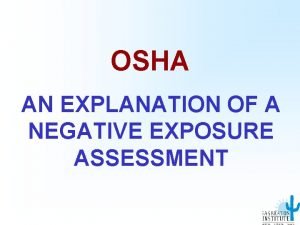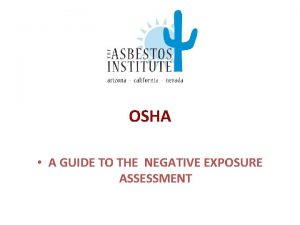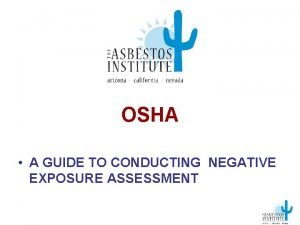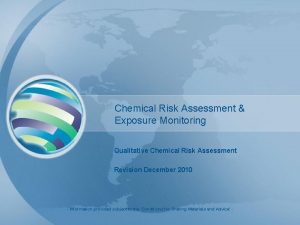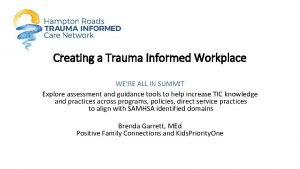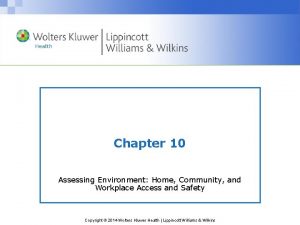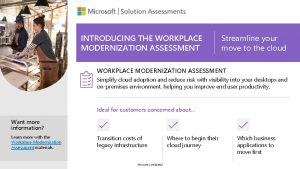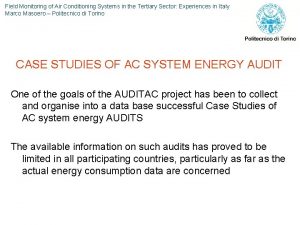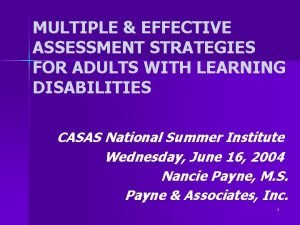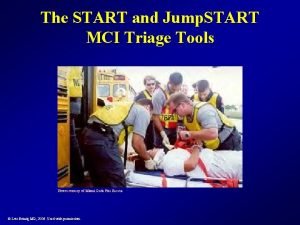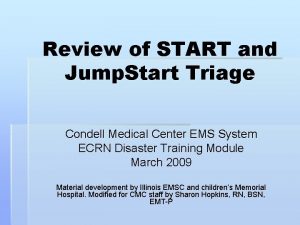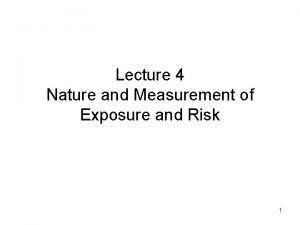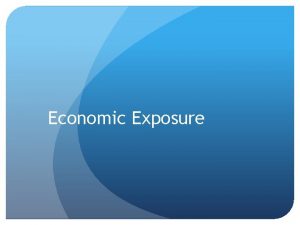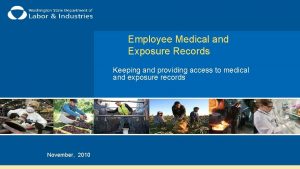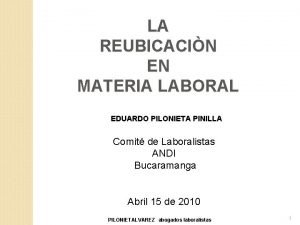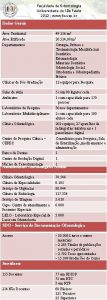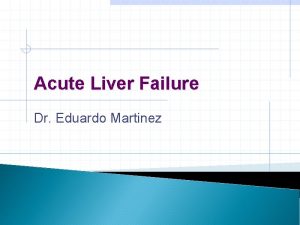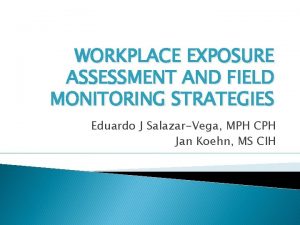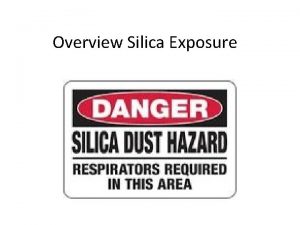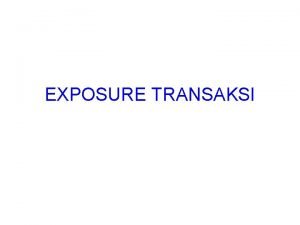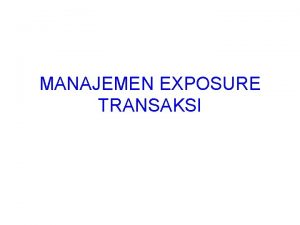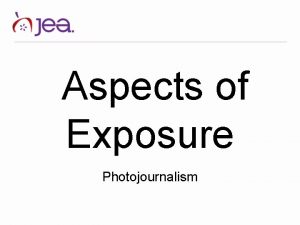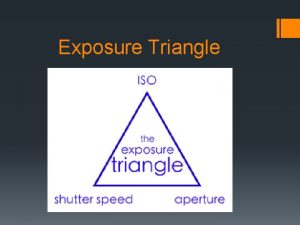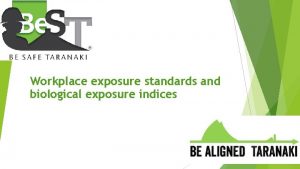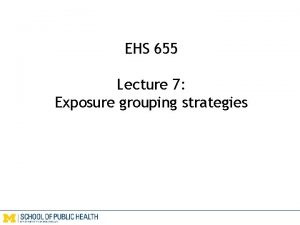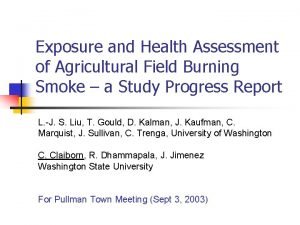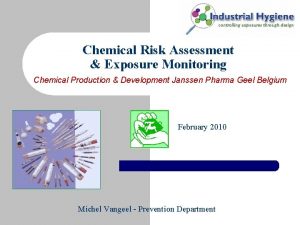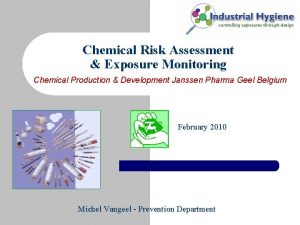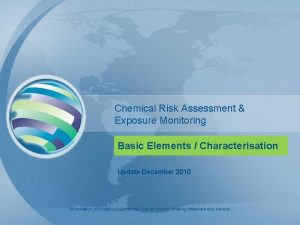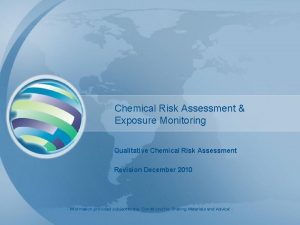WORKPLACE EXPOSURE ASSESSMENT AND FIELD MONITORING STRATEGIES Eduardo






















































- Slides: 54

WORKPLACE EXPOSURE ASSESSMENT AND FIELD MONITORING STRATEGIES Eduardo J Salazar-Vega, MPH CPH Jan Koehn, MS CIH

BASIC ELEMENTS Industrial Hygiene (IH) is that science devoted to the anticipation, recognition, measurement, evaluation, and control of adverse stresses or agents which could cause sickness and impaired health among workers and the community. The basic goal of IH is to promote a safe and healthful work environment.

INDUSTRIAL HYGIENE �Anticipation �Recognition �Evaluation �Control

EXPOSURE ASSESSMENT SYSTEM Integrated with other systems for defining, prioritizing, and managing worker health protection.

ASSESSMENT RESULTS Used to determine the needs and priority for health hazard controls, build exposure histories, and demonstrate regulatory compliance.

EXPOSURE CHARACTERIZATION State-of-the-art approach has shifted from compliance monitoring which focuses on the maximum-risk employee to determine whether exposures are above or below established limits, to comprehensive exposure assessment, which emphasizes characterization of all exposures for all workers on all days.


STRATEGY OVERVIEW Basic Characterization Exposure Assessment Further Information Gathering Health Hazard Control Reassessment Documentation


BASIC CHARACTERIZATION • • • Collect and organize information Understand tasks being performed, materials used, process operations, and control measures Develop exposure conditions

EXPOSURE ASSESSMENT • • • Define Similar Exposure Groups (SEGs) Define exposure profiles Determine acceptability of exposure profiles for each SEG

FURTHER INFORMATION GATHERING • Exposure Monitoring • Exposure Modeling • Biological Monitoring • Toxicological Data Generation • Epidemiological Data Generation

HEALTH HAZARD CONTROLS Prioritized based on findings from exposure assessment Diagnostic monitoring can be employed

REASSESSMENT Updates on a timely basis Comprehensive management-ofchange process

DOCUMENTATION Communication Recommendations Record Keeping

EXPOSURE ASSESSMENT GOALS Comprehensive Strategy Compliance Strategy Limited, Specific Survey


WALK-THROUGH SURVEY 1. 2. 3. 4. 5. 6. Hazardous agents in workplace Health effects associated with excessive exposures OELs for each agent Workforce organization and staffing Significant sources of exposure; process separations and tasks and work procedures involved Control measures

SOURCES OF INFORMATION Facility tour and observations Personnel interviews Record reviews Regulatory standards Literature

ENVIRONMENTAL AGENTS Type of agent Use and properties Routes of exposure Potential health effects Pertinent OELs

CATEGORIES OF AGENTS �Raw Materials �Intermediates �Products �Byproducts �Additives �Maintenance/construction Materials �Laboratory Chemicals �Hazardous Waste �Physical Agents �Biological Agents


SEGs DETERMINANTS Process Job Task Environmental Agent

EXPOSURE ASSESSMENT Tiered, cyclic process Qualitative/Quantitative Level of uncertainty about specific level of exposure OELs reference (10%) Modeling

INITIAL ASSESSMENT Qualitative Data Quantitative Dara Exposure Assessment

EXPOSURE SCENARIOS � Minor: if expected exposure is less than 1/10 OEL, if it is not likely to have an adverse effect to health, or if exposure does not create a regulatory issue. Major: if expected exposure is equal or greater than 1/10 OEL, if it is likely to have an adverse effect to health, or if exposure creates a regulatory issue.

EXPOSURE RATINGS

EXPOSURE RATINGS They can be defined based on: : § Monitoring data. Datos de monitoreo § Personal sampling § Reference measures § Surrogate data § Data from exposure to other agents § Data from exposure to other operation/process § Modeling § Based on physical and chemical properties § Based on process’ information



CHARACTERIZING THE EXPOSURE

CHARACTERIZING THE EXPOSURE

ACCEPTABLE EXPOSURES Exposure and variability are low enough to create no more than the minimal risk associated with the exposure profile. They might not need immediate action, but monitoring is performed to verify them.

UNACCEPTABLE EXPOSURES They are easier to determine. ◦ Exposure values are high enough, e. g. exceed the OEL ◦ There is evidence of adverse health effects, e. g. a worker passed out as a consequence of a hot environment (heat stress) ◦ If dermal contact is observed when the dermal route is an important route of exposure.

UNCERTAIN EXPOSURES Exposure cannot be classified as acceptable nor unacceptable. There is no conclusion. ◦ Few data ◦ Many dermal exposures fall into this category. It can be solved in two different ways ◦ Collecting additional data. ◦ Categorizing the exposure as unacceptable and controlling it.



FURTHER INFORMATION GATHERING Exposure profile Judge acceptable at “ 10%of OEL” Resolve uncertainties Prioritization of SEGs

MONITORING Measurement of exposure concentrations during a given time period. Monitoring data are used to help resolve, refine, or confirm the exposure assessment.

MONITORING OBJECTIONS Baseline Compliance Diagnostic

EXPOSURE PATHWAYS Inhalation Ingestion Skin or Eye Absorption

EXPOSURE MONITORING Area Personal Averaging Times

OCCUPATIONAL EXPOSURE LIMITS �OSHA PELs �ACGIH TLVs �NIOSH RELs �AIHA WEELs

MONITORING PERIODS Full-shift 8 -hour Time Weighted Average Short-Term Exposure Limits (STELs) 15 -30 minute work tasks Ceiling limits

SAMPLING STRATEGY DESIGN Who What Where When Why How Many How Long How to Sample

WHY QUESTION? Regulatory Compliance Corporate Requirement Comprehensive Description Establish Exposure Levels Diagnostic Evaluation Risk Assessment

WHAT QUESTION? Everything? Workplace Inventory Exposure Assessment Priority Ranking System

WHERE QUESTION? Process Operations Loading/Unloading Areas Blending Locations Maintenance/Repairs Storage

WHEN QUESTION? Multiple Shifts Different Seasons Variable Weather Manufacturing Methodologies e. g. cyclic, batch, continuous

WHO QUESTION? Operations Maintenance Laboratory Support Transportation

HOW LONG QUESTION? Full-shift Partial Period Short-term Grab Samples Others

HOW MANY QUESTION? Potential Elevated Exposures Representative “Worst-case”

Questions?

SCENARIOS AND APPLICATIONS
 Managing economic exposure and translation exposure
Managing economic exposure and translation exposure Transaction exposure and economic exposure
Transaction exposure and economic exposure Managing economic exposure and translation exposure
Managing economic exposure and translation exposure Translation exposure
Translation exposure What is a negative exposure assessment
What is a negative exposure assessment Negative exposure assessment
Negative exposure assessment Negative exposure assessment
Negative exposure assessment Qualitative exposure assessment
Qualitative exposure assessment Hse
Hse Workplace readiness assessment
Workplace readiness assessment Trauma-informed workplace assessment
Trauma-informed workplace assessment Workplace environmental assessment
Workplace environmental assessment Workplace modernization assessment
Workplace modernization assessment What is comprehension monitoring
What is comprehension monitoring Magnitude of magnetic force
Magnitude of magnetic force Distinguish between magnetic and nonmagnetic materials
Distinguish between magnetic and nonmagnetic materials Database field types and field properties
Database field types and field properties Field dependent and field independent
Field dependent and field independent Magnetic field
Magnetic field Centre for assessment and monitoring
Centre for assessment and monitoring Ac field monitoring
Ac field monitoring Assesment strategies
Assesment strategies Field dependent vs field independent
Field dependent vs field independent Field dependent vs field independent
Field dependent vs field independent Waveguide cutoff frequency
Waveguide cutoff frequency Assessment strategies for adults
Assessment strategies for adults Jump start in field traige assessment
Jump start in field traige assessment Jump start triage
Jump start triage Jump start algorithm
Jump start algorithm Nature of exposure and risk
Nature of exposure and risk Measuring and managing operating exposure
Measuring and managing operating exposure Non-marketer dominated stimuli
Non-marketer dominated stimuli Measuring and managing economic exposure
Measuring and managing economic exposure Access to medical and exposure records
Access to medical and exposure records Eduardo araujo pradere
Eduardo araujo pradere Eduardo nunca (entrenarse) tanto en invierno
Eduardo nunca (entrenarse) tanto en invierno Adjetivos con rr
Adjetivos con rr Eduardo perseu de paiva
Eduardo perseu de paiva Circolo didattico eduardo de filippo
Circolo didattico eduardo de filippo Eduardo novoa
Eduardo novoa Los alumnos galeano
Los alumnos galeano Eduardo garin abarzua
Eduardo garin abarzua Eduardo pilonieta pinilla
Eduardo pilonieta pinilla Eduardo correa psiquiatra
Eduardo correa psiquiatra Ic eduardo de filippo sant'egidio del monte albino
Ic eduardo de filippo sant'egidio del monte albino Musico gallego
Musico gallego Bolsa eduardo panadés
Bolsa eduardo panadés Normobúlico significado
Normobúlico significado Eduardo mata montessori
Eduardo mata montessori La muda de la flor eduardo kingman
La muda de la flor eduardo kingman Eduardo harada
Eduardo harada Eduardo conde
Eduardo conde Acto juridico ejemplos
Acto juridico ejemplos Dr eduardo martinez
Dr eduardo martinez Invariáveis
Invariáveis




